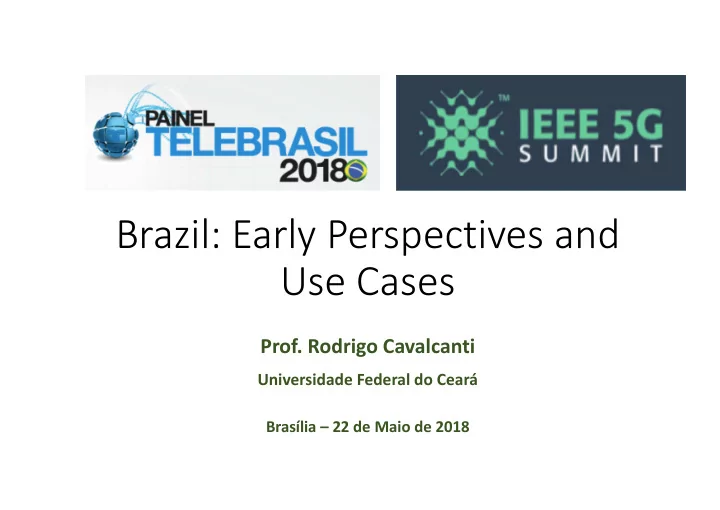

Brazil: Early Perspectives and Use Cases Prof. Rodrigo Cavalcanti Universidade Federal do Ceará Brasília – 22 de Maio de 2018
Institutional Info FEDERAL UNIVERSITY OF CEARA www.gtel.ufc.br FORTALEZA, BRAZIL www.ufc.br
BRAZIL - EU H2020 Projects
FUTEBOL Project F ederated U nion of T elecommunications Research Facilities for an E U- B razil O pen L aboratory 2016-2019 Partners: • Trinity College • UFC • Univ. of Bristol • UFES • VTT Finland • UFMG http://www.ict-futebol.org.br • iT Portugal • UFRGS • Intel (Germany) • Unicamp
Remote Area Access Network for the 5th Generation 5G-RANGE receives funding from the European Union Horizon 2020 Programme (H2020/2017-2019) under grant agreement n � 777137 and from the Ministry of Science, Technology and Innovation of Brazil through Rede Nacional de Ensino e Pesquisa (RNP) under the 4 th EU-BR Coordinated Call Information and Communication Technologies.
Main Objective • To provide reliable Internet access in remote areas using a innovative 5G mode at an affordable price.
The Digital Divide in ICT [1] Imme Philbeck, CONNECTING THE UNCONNECTED Working together to achieve Connect 2020 Agenda Targets, ITU White Paper, 2017.
Technology Challenge Capacity & Spectral Efficiency Mbps/Hz Energy Efficiency Bits/Joule & battery autonomy Deployment Efficiency Cost per Coverage & Throughput
Geographical Challenge Ceara state, Northeast Brazil State population: aprox. 9M Fortaleza (capital): aprox. 2.7M Population Density • Fortaleza: 8.000/km2 • Ceara (minus Fortaleza): 42/km2
The General Picture
Specific Use Cases
Requirements • Large Coverage § Low population density regions demands for large cells § 5G-RANGE target: 50 km • Broadband connection § Reliable and high quality broadband connection. § 5G-RANGE target: 100 Mbps @ cell edge • Mobility § Support for drones, cars and trains § 5G-Range target: 120km/h
Core Technologies • Built-in Flexibility into PHY layer. • Cognitive Radio at LINK layer • Spectrum sharing (TV White Spaces) • Low order MIMO (up to 4x4)
TV White Spaces • High correlation between low population density and amount of unused tv broadcast channels. • Below 1 GHz spectrum • Good propagation range
Planned Field Trials • Field Test to be deployed in Santa Rita do Sapucaí: § Coverage § Throughput § Robustness § Mobility
Final Messages • 5G can overcome the last frontier for universal Internet access. • Challenging requirements (performance, cost) for remote areas can be matched by 5G-RANGE combined set of core technologies. • Satellite and fiber are complementary, not competing technologies. • Field tests are necessary to confirm laboratorial/simulation-based evaluations.
Prof. Rodrigo Cavalcanti E-mail: rodrigo@gtel.ufc.br www.5g-range.eu 5G-RANGE Coordinator (in Brazil) Prof. Luciano Mendes (Inatel) Luciano@inatel.br
Recommend
More recommend